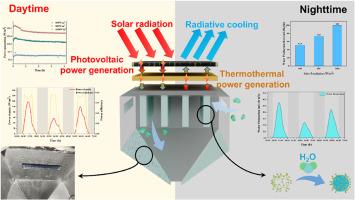一种新型光伏驱动岛式双功能发电与大气集水系统性能分析
IF 9.4
1区 工程技术
Q1 ENERGY & FUELS
引用次数: 0
摘要
这项研究解决了岛屿社区获得可靠电力和淡水的关键挑战,在这些岛屿社区,传统的供应方法既昂贵又不可持续。为了解决这个问题,我们开发并实验验证了一种混合PV-TEG-MOF系统,该系统将太阳能发电与基于吸附的大气集水结合在一起。合成了高性能MIL-101(Cr)/Fin复合材料,并与光伏和热电模块耦合,随后在受控的实验室条件和真实的室外环境下进行了测试,并进行了数值模拟支持。结果表明,在1000 W/m2辐照条件下,平均PV输出功率为130 W/m2, TEG功率为3.34 W/m2,产水量为100 mL/(kg·h)。室外试验的PV输出为48 W/m2,夜间TEG输出为1.74-1.58 W/m2,日出水量为240 mL/m2。模拟证实,一个1000平方米的系统可以提供120瓦/平方米的电力和66毫升/(m2·h)的水,满足300人的日常需求。这些发现表明,该系统有潜力成为一个可扩展的、可持续的解决方案,用于偏远岛屿的综合能源-水供应,减少对外部供应的依赖,并支持有弹性的低碳资源安全。本文章由计算机程序翻译,如有差异,请以英文原文为准。

The performance analysis on a novel PV driven island dual-functional power generation and atmospheric water harvesting system
This research addresses the critical challenge of reliable electricity and freshwater access for island communities, where conventional supply methods are costly and unsustainable. To tackle this, we developed and experimentally validated a hybrid PV–TEG–MOF system that integrates solar power generation with sorption-based atmospheric water harvesting. A high-performance MIL-101(Cr)/Fin composite was synthesized and coupled with photovoltaic and thermoelectric modules, followed by testing under controlled laboratory conditions and realistic outdoor environments, supported by numerical modeling. Results showed under 1000 W/m2 irradiation an average PV output of 130 W/m2, TEG power of 3.34 W/m2, and water production of 100 mL/(kg·h). Outdoor tests yielded 48 W/m2 PV output, 1.74–1.58 W/m2 nocturnal TEG output, and 240 mL/m2 daily water yield. Simulations confirmed that a 1000 m2 system could provide 120 W/m2 electricity and 66 mL/(m2·h) water, meeting daily needs of 300 people. These findings demonstrate the system's potential as a scalable, sustainable solution for integrated energy–water provision in remote islands, reducing dependency on external supplies and supporting resilient, low-carbon resource security.
求助全文
通过发布文献求助,成功后即可免费获取论文全文。
去求助
来源期刊

Energy
工程技术-能源与燃料
CiteScore
15.30
自引率
14.40%
发文量
0
审稿时长
14.2 weeks
期刊介绍:
Energy is a multidisciplinary, international journal that publishes research and analysis in the field of energy engineering. Our aim is to become a leading peer-reviewed platform and a trusted source of information for energy-related topics.
The journal covers a range of areas including mechanical engineering, thermal sciences, and energy analysis. We are particularly interested in research on energy modelling, prediction, integrated energy systems, planning, and management.
Additionally, we welcome papers on energy conservation, efficiency, biomass and bioenergy, renewable energy, electricity supply and demand, energy storage, buildings, and economic and policy issues. These topics should align with our broader multidisciplinary focus.
 求助内容:
求助内容: 应助结果提醒方式:
应助结果提醒方式:


